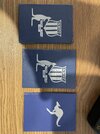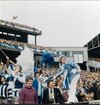Whoops one final
2x 1974 members cards and a 1975 one as well
Some great history here of the club and as I said I’d like to see it with someone who has a vested interest in the club these days. As I said feel free to PM me if you’re interested in making an offer on any or all of the items
2x 1974 members cards and a 1975 one as well
Some great history here of the club and as I said I’d like to see it with someone who has a vested interest in the club these days. As I said feel free to PM me if you’re interested in making an offer on any or all of the items










